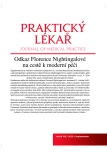Clinical simulation as a method in midwifery teaching
Authors:
M. Moravcová 1; E. Welge 1
Authors‘ workplace:
Univerzita Pardubice, Fakulta zdravotnických studií, Katedra porodní asistence a zdravotně sociální práce
1
Published in:
Prakt. Lék. 2020; 100(Supplementum): 33-37
Category:
Overview
Aim: The main aim of this research survey is to describe methodology behind simulation situations for midwifery students studying towards bachelors degree and to evaluate their effect on the students.
Methods: The respondents were sixteen midwifery third year students. The students actively participated in simulation scenarios in a subject Porodní Asistence III. at Faculty of Health Studies in University of Pardubice from September to November 2019. The research survey was based on teaching simulated situations with immediate feedback from teachers, evaluation straight after from the respondents as well as with the focus group and via written feedback. The aim of facilitated discussion was to identify shortfalls in simulation teaching with good practice and educational method in mind. Furthermore, the students anonymously gave written evaluation.
Results: Methodology for each simulation was made and they formed part of the teaching. The simulations were mainly seen as a good way for learning. The biggest benefit was learning midwifery skills in real like situations, team work and effective communication.
Conclusion: Based on the results, learning through simulation seems as an effective method for pre-degree midwifery students mainly with the aim on obstetric emergencies. .
Keywords:
Simulation – midwifery – education.
Sources
- Advanced Life Support in Obstetrics (2009) Advanced Life Support in Obstetrics. (5th ed.) Leawood: American Academy of Family Physicians.
- Andersen, P., Downer, T., O’Brien, S., & Cox, K. (2019) Wearable Simulated Maternity Model: Making Simulation Encounters Real in Midwifery. Clinical Simulation in Nursing, 33(1), 1-6.
- Hendl, J., & Remr, J. (2017). Metody výzkumu a evaluace. Praha: Portál. ISBN 978-80-262-1192-1.
- Honey, P., & Mumford, A. (1992). The manual of learning styles. Maidenhead: P. Honey.
- Kolb, D. (1984). Experiential learning. Englewood Cliffs, N. J.: Prentice-Hall.
- Krishnan, D. G., Keloth, A. V., Ubedulla, S. (2017) Pros and cons of simulation in medical education: A review. Int.Jour. of Medical and health Research, 3(6), 84-87.
- Morgan, D., & Krchová, J. (2001). Ohniskové skupiny jako metoda kvalitativního výzkumu. Boskovice: Albert. ISBN 80-85834-77-4.
- Mukhalalati, B. A., Taylor, A. (2019) Adult Learning Theories in Context: A Quick Guide for Healthcare Professional Educators. Retrieved from https://www.ncbi.nlm.nih.gov/pmc/articles/PMC6458658/.
- NHS Health Education England, Leeds (2019). Simulation. Retrieved from https://www.hee.nhs.uk/our-work/simulation.
- Pasztor, A., Carey, S. (2011) United Continental Pilots Split on Training Simulators. Retrieved from https://www.wsj.com/articles/SB10001424052702304887904576395850731566080.
- Patton, M. Q. (2002). Qualitative Research and Evaluation Methods. London: Sage. ISBN 0761919716.
- So, H. Y., Chen, P., Wong, G. K. C., and Chan, T. N. (2019) Simulation in medical education. Journal of the Royal Physicians of Edinburgh, 49(1), 52-57.
- Statista. (2020) 2019 Was A Safe Year For Air Travel Despite MAX Woes. Retrieved from https://www.statista.com/chart/12393/2017-was-the-safest-year-in-the-history-of-air-travel/.
- Villancourt R. (2009) “I Hear and I Forget, I See and I Remember, I Do and I Understand” Retrieved from https://www.ncbi.nlm.nih.gov/pmc/articles/PMC2826962/ [cit.2020-22-02].
- WHO. (2009). Patient safety. Retrieved from https://www.who.int/health-topics/patient-safety/#tab=tab_1.
Labels
General practitioner for children and adolescents General practitioner for adultsArticle was published in
General Practitioner

Most read in this issue
- Factors Influencing Job Satisfaction and Motivation of General Nurses
- Nurses‘ Role in Prescribing Medication
- Coping of students in study programs General nursing and Paramedic
- Clinical simulation as a method in midwifery teaching
